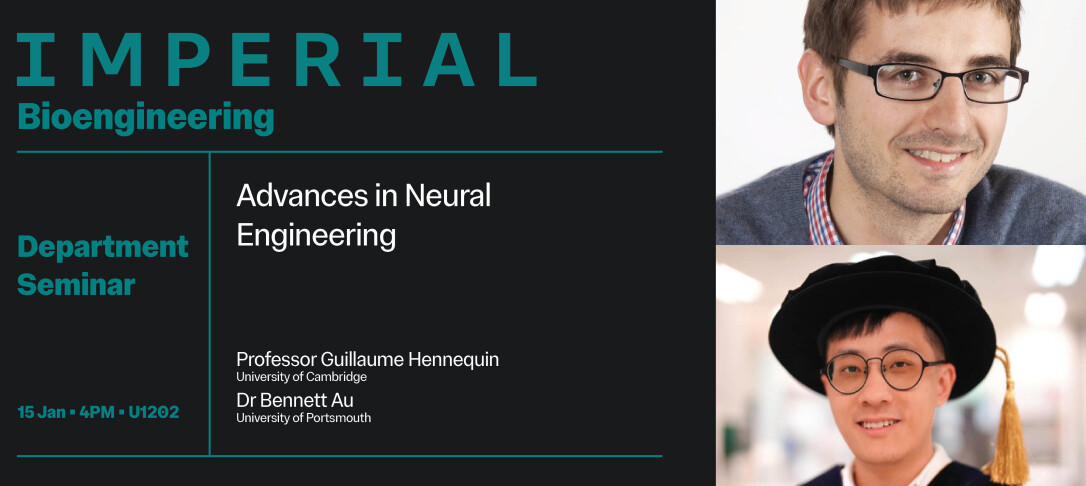
Join us for the first Bioengineering Department Seminar of 2025, where we’ll explore cutting-edge advancements in neural engineering.
Professor Guillaume Hennequin and Dr Bennett Au will present their novel research on neural regeneration and multi-area computation.
As always, refreshments will be served immediately after this seminar.
 Guest speaker one:
Guest speaker one:
Professor Guillaume Hennequin, Professor of Computational Neuroscience, University of Cambridge
Data-driven circuit models reveal the dynamics of consensus across visual areas in mice
The neocortex is composed of functionally specialized areas, but it remains unclear how these regions collectively form percepts and implement cognitive processes. We investigated the joint neural dynamics of primary (V1) and higher-order (LM) visual areas in mice using simultaneous multi-area recordings and optogenetic perturbations. By combining mechanistic circuit modelling with state-of-the-art nonlinear system identification, we fitted biologically-constrained latent circuit models to the data, and interrogated them. We found that long-range, reciprocal excitatory connections between V1 and LM implement an approximate line attractor in their joint dynamics. This line attractor promotes activity patterns that reflect a multi-area consensus about the presence of a visual stimulus, and suppresses conflicted activity patterns. This principle can be generalized to accommodate consensus about more detailed features of the stimulus, and makes specific neural predictions which we independently verified in the data. By linking the anatomical organization of inter-area connections to the features they reconcile across areas, our work introduces a general theory of multi-area computation.
 Guest speaker two:
Guest speaker two:
Dr Bennett Au, Senior Lecturer, University of Portsmouth
Unlocking neuronal regenerative potential as a therapeutic strategy to enhance functional recovery after traumatic injuries
Traumatic injuries to the nervous system remain a leading cause of disability worldwide. In the adult mammalian central nervous system (CNS), injured neurons are unable to regenerate effectively due to their limited intrinsic regenerative capacity and the hostile, growth-inhibitory extrinsic microenvironment at the lesion site. This regeneration failure often leads to permanent and irreversible functional deficits in patients with CNS injuries, such as spinal cord injury, traumatic brain injury, and traumatic optic neuropathy. In contrast, neurons in the peripheral nervous system (PNS) are capable of axonal regeneration; however, the rate is extremely slow (i.e. 1-2 mm per day). Motor functional recovery is only possible if regenerated axons reach their distal targets and re-establish functional synapses at the motor end plates within a limited time window termed ‘critical period’. For patients with proximal peripheral nerve injuries (PNI) requiring long-distance axon regeneration, motor functional recovery is often suboptimal because muscle atrophy occurs before the axons successfully reconnect with their targets. These challenges highlight the urgent need for novel therapeutic strategies to accelerate axon regeneration and improve functional outcomes following nerve injuries in both PNS and CNS.
In this seminar, I will present my latest research findings on strategies aimed at promoting axon regeneration and functional recovery following PNS and CNS injuries. The first part of the presentation will focus on my recent findings demonstrating the potent neuroprotective effects of low-dose ionising radiation (LDIR) in promoting motor functional recovery following traumatic brain injury, ischaemic stroke, and PNI. Through genome-wide DNA methylation analysis, we identified Fmn2 as a key gene mediating the pro-regenerative effects of LDIR. Using an adeno-associated virus (AAV)-based gene delivery system, we successfully suppressed Fmn2 expression in injured peripheral neurons, significantly accelerating axon regeneration in vivo and facilitating early sensory and motor recovery in a mouse model of PNI. The second part of the seminar will explore innovative therapeutic approaches to sustain long-distance axon regeneration, enabling target reinnervation and improved visual recovery in a mouse model of optic nerve crush injury. I will also discuss ongoing research in my lab since joining the University of Portsmouth. These findings offer valuable insights into enhancing the intrinsic regenerative capacity of injured neurons, paving the way for the development of more effective therapies to improve nerve repair and functional recovery following nervous system injuries.